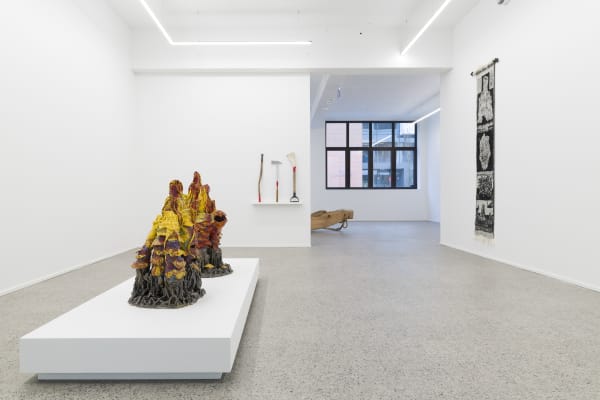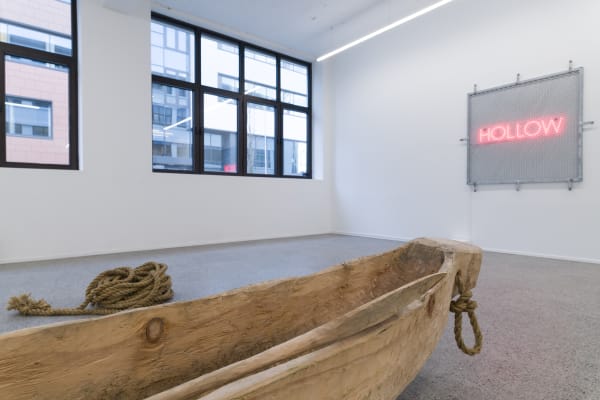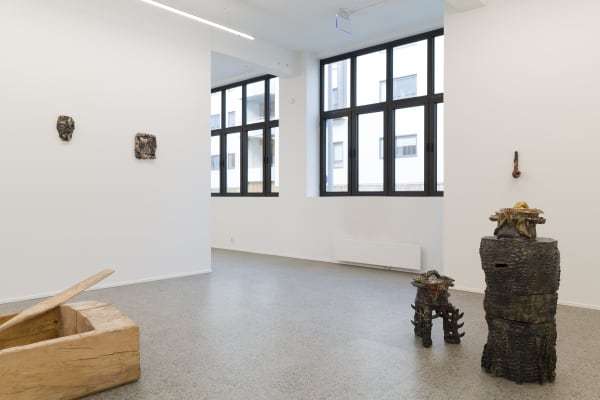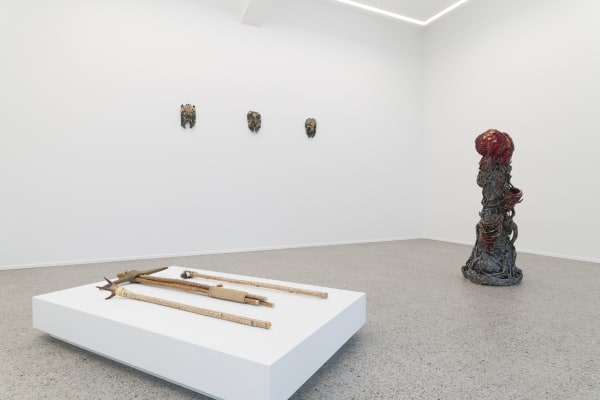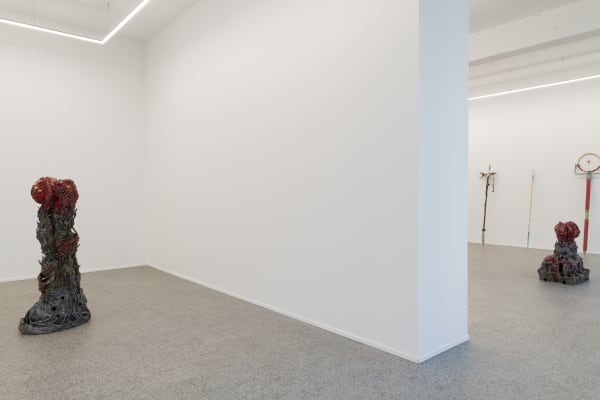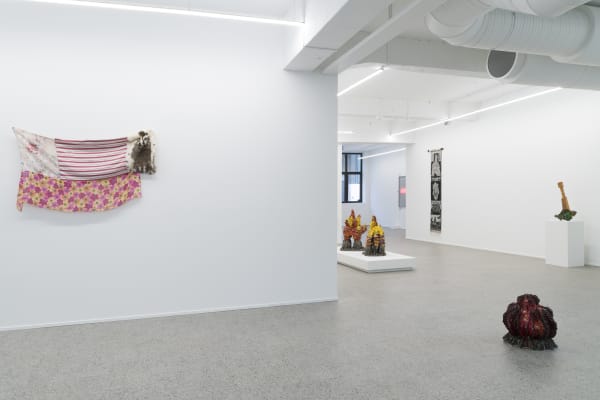Jamdøgn: Eirik Falckner & Gabriel J. Kvendseth
List of works
Jamdøgn
Høyersten Contemporary er meget glad for å kunne presentere duo-utstillingen Jamdøgn av kunstnerne Gabriel Kvendseth (f. 1984) og Eirik Falckner (f. 1995). Begge kunstnere bor og arbeider i Bergen, Norge, og dette er første gang de stiller ut sammen. Jamdøgn er i hovedsak en skulpturutstilling som viser visuelt slående objekter med innholdsmessig rike referanser.
Jamdøgn eller jevndøgn peker på de to datoer i et kalenderår (vår og høst) hvor natt og dag er like lange. Disse astronomiske fenomener har i tidligere tider vært sterkt forbundet til naturmystikk og religiøse og/eller mytologiske fortellinger av stor betydning. Jamdøgn har, på samme måte som vinter -og sommersolverv, vært sett på som særlig magiske døgn i løpet av året, forbundet til forestillinger om fødsel og død, fruktbarhet, avgrøde og livets gang og gjenfødsel, den kosmiske balanse og det sykliske med andre ord.
Felles for verkene som vises av Falckner og Kvendseth, er at de er fabulerende og lekne, utforskende og uttrykksfulle. Men grunnen til at vi har satt dem sammen er ikke basert på et delt kunstnerisk uttrykk, men snarere med utgangspunkt i noen likhetstrekk og et underliggende fellestrekk i det kunstneriske siktemål. Kvendseth og Falcker kommer begge fra en kunstnerisk praksis som setter fokus på håndverksmessig kunnskap, og på materialets og formens fenomenologiske betydninger, altså kulturelle, sosiale og idemessige innarbeidete betydninger og assosiasjoner.
Kvendseth benytter seg hovedsakelig og meget forenklet formulert, av et grep der han bygger opp nye objekter med tilsynelatende funksjoner, gjennom ting han finner. Når vi ser hans verker er det som om de er spor eller etterlatenskaper av en forsvunnet sivilisasjon eller samfunn, nærmest som et arkeologisk funn. Men det er våre ting, laget i vår tidsfære, han iscenesætter. Det er noe noe eventyrlig og lekent i hans grep. Med det grepet skaper han både distanse og nærhet, og ved å gjøre det fortrolig fremmed, inviteres vi til å se det kjente i et nytt perspektiv og med det, potensielt, avfødes nye tanker. Man kan hevde at noen av hans grep trekker trådene tilbake til den surrealistiske kunsten på 1920-tallet og “arte povera” på 1960-tallet, uten at jeg skal utdype det her.
Den samme undringen over det bestående er også tilstede i Falckners kunstnerskap. I denne utstillingen vises verk primært utført i brent leire. Hans store keramikskulpturer kan minne om koraller, soppformasjoner eller noe uhyggelig fra et sci-fiunivers. Det er som at en urkraft stiger opp av gallerigulvet. Det er drømmekatig, men også familiert. For keramikk er noe alle er i berøring med i det daglige, enten som leirgods eller porselen. Noen historikere hevder at evnen til å brenne leire til keramikk, er et av de første tegn på sivilisasjon. Raffineringen av et materiale (leire, tre, voks eller lær etc), som så får en kunstferdig form (les menneskeskapt) synes som et etablert bilde på raffineringen av mennesket. I det ligger det også en forestilling om at enhver form for raffinering også må ses som et fremskritt i menneskets evolusjon og væren, og dermed av det gode. I en digital tidsalder, med økt skjermtid, voksende isolasjon og politisk trolling, vet vi godt at så ikke er tilfelle.
Falckner velger ofte å la den kunstferdige formen anta en naturlig form, som om den ikke er skapt av menneske, men av en annen organisme. I det ligger det kanskje en kritikk av sivilisasjonens tro på den progressive utvikling.
Falckners univers hviler på en modernistisk grunnpilar, der materialet skal utforskes i sin egen art, på den ene siden, og på den andre siden, står han sterkt i en ekspressiv tradisjon, fra Munck til Pollock og Basquiat.
Som utenforstående betrakter, vil man kunne påstå at det i begge kunstnerskap er en tilbøyelighet til å søke og undersøke det arkaiske, eller ideen om noe opprinnelig. Det synes som om begge deler en fascinasjon, eller fantasi, om man vil, for det presiviliatoriske, preindustrielle, om en tid før det mekaniske, det digitale, før de økonomiske teorier og strukturer ble nedfelt. (Det er en romantisk idé like mye som det er en utopi, men likevel en idé som fremstår som en mer og mer gyldig blant mange, uansett levevei.) Kanskje ligger det en felles sørgmodighet i disse prosjektene, en erkjennelse av at den tapte uskyld aldri mer kan vinnes eller vendes tilbake til, kanskje ligger det en kritikk eller et opprør mot den retning vi tilsynelatende driver inn i.
Hos begge kunstnere ligger det en omsorg for naturen, en fascinasjon for det spirituelle som har vokst frem av naturreligioner, for det magiske og besjælete objekt, og for prosessen og det rituelle som ligger i skapelsen av noe. Det er et fellesskap i elementene av det surrealistiske og uvirkelige. Drømmen. Dette er tendenser man kan spore andre steder i samtidskunsten. Med den økte miljøbevisstheten som har vokst frem de siste tiår, og med en større forståelse for ulike økosystemer som er rådende og gjengs kunnskap, blir det naturlig å se kunstnere respondere med uttrykk, som på den ene siden kommenterer vår egen tidsalder, men som også lengter og drømmer etter noe som ikke er.
Kvendseth og Falckner beveger seg begge mellom det dystopiske og håpefulle, mellom det som har funnet sin form og det som er i bevegelse. Kanskje er det et uttrykk for en lengsel vi alle er bærere av, en lengsel etter en større balanse og likevekt. Som i et jamdøgn.
Høyersten Contemporary is very pleased to be able to present the duo exhibition Jamdøgn (Equinox) by the artists Gabriel Kvendseth (b. 1984) and Eirik Falckner (b. 1995). Both artists live and work in Bergen, Norway, and this is the first time they are exhibiting together. Jamdøgn is essentially a sculpture exhibition that shows visually striking objects with content-rich references.
Jamdøgn or equinox refers to the two dates in a calendar year (spring and autumn) where night and day are of equal length. These astronomical phenomena have in the past been strongly connected to natural mysticism and religious and/or mythological stories of great importance. The solstice has, in the same way as the winter and summer solstice, been seen as particularly magical days during the year, connected to notions of birth and death, fertility, harvest and the course of life and rebirth, the cosmic balance and the cyclical in other words.
What the works shown by Falckner and Kvendseth have in common is that they are fabulous and playful, exploratory and expressive. But the reason why we have put them together is not based on a shared artistic expression, but rather based on some similarities and an underlying commonality in the artistic aim. Kvendseth and Falcker both come from an artistic practice that focuses on artisanal knowledge, and on the phenomenological meanings of the material and form, i.e. cultural, social and ideological incorporated meanings and associations.
Kvendseth mainly uses, and very simply formulated, a technique where he builds up new objects with apparent functions, through things he finds. When we see his works, it is as if they are traces or remains of a vanished civilization or society, almost like an archaeological find. But it is our things, made in our time sphere, that he stages. There is something somewhat adventurous and playful in his grip. With that grip, he creates both distance and closeness, and by making it intimately foreign, we are invited to see the familiar in a new perspective and with that, potentially, new thoughts are born. One could argue that some of his moves draw the threads back to the surrealist art of the 1920s and "arte povera" of the 1960s, without me going into detail here.
The same wonder at what exists is also present in Falckner's artistry. In this exhibition, works primarily made in burnt clay are shown. His large ceramic sculptures can resemble corals, mushroom formations or something sinister from a sci-fi universe. It is as if a primal force rises up from the gallery floor. It is dreamy, but also familiar. Because ceramics is something everyone comes into contact with on a daily basis, either as earthenware or porcelain. Some historians claim that the ability to fire clay into pottery is one of the first signs of civilization. The refinement of a material (clay, wood, wax or leather etc), which then takes on an artful form (read man-made) seems like an established image of the refinement of man. It is also a notion that any form of refinement must also be seen as an advance in human evolution and being, and thus of the good. In a digital age, with increased screen time, growing isolation and political trolling, we know very well that this is not the case.
Falckner often chooses to let the artificial form assume a natural form, as if it was not created by man, but by another organism. Therein lies perhaps a criticism of civilization's belief in progressive development.
Falckner's universe rests on a modernist foundation, where the material is to be explored in its own way, on the one hand, and on the other hand, he stands strongly in an expressive tradition, from Munck to Pollock and Basquiat.
As an outside observer, one would be able to claim that in both artistry there is a tendency to seek and investigate the archaic, or the idea of something original. It seems as if both share a fascination, or imagination, if you will, for the pre-civilizational, pre-industrial, of a time before the mechanical, the digital, before economic theories and structures were laid down. (It is a romantic idea as much as it is a utopia, but nevertheless an idea that appears to be more and more valid among many, regardless of the way of life.) Perhaps there is a common sadness in these projects, a recognition that the lost innocence can never be won or returned to, perhaps there is a criticism or a rebellion against the direction in which we are apparently drifting.
In both artists there is a concern for nature, a fascination for the spiritual that has grown out of nature religions, for the magical and soulful object, and for the process and the ritual that lies in the creation of something. There is a community in the elements of the surreal and the unreal. The Dream. These are tendencies that can be traced elsewhere in contemporary art. With the increased environmental awareness that has grown in recent decades, and with a greater understanding of the various ecosystems that are prevalent and common knowledge, it becomes natural to see artists respond with expressions, which on the one hand comment on our own age, but which also yearn and dream for something that is not.
Kvendseth and Falckner both move between the dystopian and the hopeful, between what has found its form and what is in motion. Perhaps it is an expression of a longing we all carry, a longing for greater balance and equilibrium. As in a Jamdøgn.
Eirik Falckner
Eirik Falckner (b. 1995) is a multidisciplinary artist who works with sculpture, video, performance, printmaking, textile and installations. His work has an organic aesthetic, drawing inspiration from nature, fossils, corals and mysteries of the past. Eirik has a background from graffiti writing, which he has developed further in his ritualistic installations and wall paintings in public space. An ongoing theme throughout the work is the modern human being meeting prehistoric and powerful nature that is our basis of life.
Eirik Falckner is a pseudonym for an artist who graduated from KMD. The artist's choice of a pseudonym, or alias, has several reasons. One of them is that the artist has had a past in an urban underground culture and graffiti environment, where anonymity has been important. Falckner also always wears a mask when he does his performances. This staging of name and figure, on the artist's part, has its clear role models in the Norwegian black metal environment and, secondarily, from a common practice in the music field. One could say that Falckner has created an alter ego that both has an artistic aim, but which is also based on a desire to be anonymous. But why this desire for anonymity? We live in a society that has a strong focus on the individual, identity and self-exposure. So, by choosing anonymity as a strategy, it can also be read as a reactionary withdrawal and taking a stand against the personal focus in the art field.
gabriel Johann kvendseth
Gabriel Johann Kvendseth's (b. 1984) artistic practice happens at an intersection between art and craft focusing on sculpture in an expanded sense, while also encompassing writing, performance and interactive installation. For many years he has worked with found objects which he manipulates intuitively into artworks that resemble weapons, tools or ceremonial artifacts without any clear timeline to them, belonging equally to the past, the present and potential futures.






